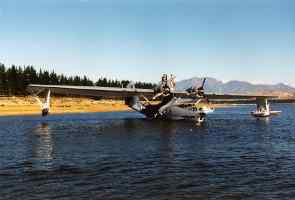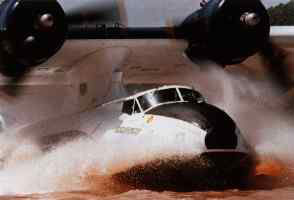Four Days in a Cat:
Flying a
Flying Boat Inside Africa
PBY Catalina N9521C
![]()
Story and Images Supplied by Chuck Ellsworth
![]()
 Day One
Day One
With the temperature at two degrees C. take-off poses no problem. The weather en-route is excellent and we have filed V.F.R. for the next two-days flight. Whenever possible I have found it easier to fly V.F.R. in most of Africa because of the difficulty with radio communications at the altitudes we normally fly the Catalina. The terrain from Johannesburg is sparsely settled with low mountain ranges through Zimbabwe, Mozambique and into Malawi. The dense jungle we associate with Africa occurs only in a relatively narrow band at the equator. If fact, a lot of Southern Africa is quite barren until you get into the central part of the continent. A highlight of this trip was to be crossing the Zambezi River half way through Mozambique. Not only is the Zambezi famous for its Victoria Falls but also it was especially important to my wife Pene, who was with me on this ferry trip, and myself. We had canoed part of the river in Zimbabwe two years previous to this flight.

We arrived Lilongwe at three fifteen in the
afternoon and two hours later finished fuelling and had cleared customs
and immigration. We had no trouble finding a cab. Finding a hotel,
however, was another matter. In the end all we could find was a very poor
quality cheap hotel and when we asked if there was a restaurant nearby the
desk clerk informed us the hotel had a restaurant just outside next door.
Judging by the quality of the hotel we thought maybe we could wait and eat
the next day. Hunger finally decided for us and it turned out to be the
best meal of the entire trip. It was a Korean restaurant and the food was
diverse and delicious. You just never know until you try.
I have been in over twenty countries in
Africa and Malawi is by far the best. The people are not only very
friendly but everywhere you go it is absolutely clean unlike most of
Africa. There is no garbage or junk anywhere. As well the plants and trees
in the city are very healthy and colourful and well looked after.
Day Two
After the easiest customs, immigration and fee-paying routine I have experienced anywhere in the many countries that I have flown in we were airborne for Nairobi Kenya at seven thirty A.M.Once again we had perfect weather for our trip through central Tanzania. Shortly after departing Lilongwe we flew across Lake Malawi famous for its diverse species of fresh water fish. There cannot be a better way to sightsee than from the big blisters on the P.B.Y. Catalina. The view is panoramic as you can see not only ahead and behind but straight down as well. The dry savanna countryside is similar to the previous days flight. We decided to take the Eastern route into Kenya to see Mt. Kilimanjaro. This, however, was not to be as most of the mountain was hidden in cloud cover.
Approaching Kilimanjaro we contacted the arrival controller to position report and were advised to report ten minutes prior to the Kenya F.I.R. Next, we were given a handoff frequency for Nairobi radar, but we were unable to raise Nairobi because of our distance and low altitude. I gave this no thought at the time, as I had not expected an answer at that altitude.
Crossing from Tanzania into Kenya we were able to identify many kinds of wildlife from our altitude of fifteen hundred feet above ground, the minimum allowed when flying over the African plains so as not to disturb the wildlife. From this height we can easily identify the big game such as Giraffe, Rhino, Buffalo, and Elephant. The smaller Zebra and Wildebeest are plentiful on the vast plains of the Serengeti and you could almost reach out with your finger tips and brush their backs from the bubble of the Catalina.
Our arrival at Nairobi’s Jomo Kenyatta airport, elevation 5300 feet, was uneventful until ground control advised me that arrival requested I go to their radar room as they wished to talk to me. Before leaving the airplane I told the rest of the crew that this might take some time as I suspected this would be another typical African shakedown. Sure enough the controllers wanted to know why I had not reported the Kenya F.I.R. on their frequency. When I explained the altitude problem they asked why I did not call on H.F. I informed them I did not have H.F. however I had brought my over flight and landing clearances for all the Countries we were fly into or over including their airport.
I never did really understand exactly what obscure rule of theirs I may have violated resulting in their threat to charge me and seize the airplane. One only has to understand the game being played which is finding a way to receive forgiveness for your stupidity in having done whatever it was they decided you are guilty of. In this case after over an hour of arguing, pleading and going around in circles one of the controllers went for a walk with me. In return for a gift of one hundred and fifty U.S. dollars to show how happy I was with his decision not to charge me I was free to go. I couldn’t believe how cheaply I had gotten away this time. I must be getting good at the game.
Kenya is one of the most corrupt countries in the world. Graft is everywhere especially in the police force. We better hope that some of our Canadian politicians do not decide to vacation there, as they will really get a chance to polish their skills in how to extort money out of us. Allow me to diverse for a moment while I am on this subject and compare the police in Africa versus British Columbia where I live. The way I see it in Africa the police extort money holding an A.K. 47. In B.C. the police are holding a radar gun; just a slightly different method.
We had planned on a one-day layover in Nairobi before continuing on to Djibouti our next fuel stop. This became a five day delay because the first officer decided to return to California and several days later Dudley Lieveaux, our engineer, had to return to South Africa to his maintenance business in Cape Town. I was really sorry to lose Dudley as he was a very experienced pilot and engineer and we would have to wait until London to replace him.
We now had several days to spare so Pene and I decided to take a day Safari and see more of Kenya and its wildlife. The safari was really worth the three hundred and fifty U.S. dollars as one never sees too much of Africa. All of the African game guides have an incredible knowledge of their country and its wildlife and vegetation. There is no better way to explore the country close up.
On Tuesday, five days after arriving in Nairobi, our new first officer Richard Maier arrived from Johannesburg. We were unable to depart the following day because of low cloud cover preventing us from navigating the route V.F.R. The terrain is very mountainous to the north east of Nairobi. It was not possible to file I.F.R. as the M.E.A. is 21,000 feet and the P.B.Y. will not reach this altitude. Our greatest concern now was running over the four days time frame the new over flight and landing permits had given us, after which you must reapply for the entire route. This would include Kenya, Ethiopia, Djibouti, Yemen, Saudi Arabia, and Egypt. Not only is getting the clearances for the route time consuming, but it costs several thousand U.S. dollars each time. This would be our third set of clearances. It did not help knowing that at this time of year Nairobi can be low overcast for weeks at a time. But we were to finally have a change of luck as the next day dawned clear and windless.
Day Three
We were up at four A.M., checked out of the hotel, and planned to get all the paperwork and fees paid in time. For the first hour it went good: we managed to pay the landing, parking and departure fees. Then it was off to the weather and flight planning offices, a walk of about half a mile. Weather planning in typical Africa is no real problem. There is very little forecast weather available for our route, so you take what you get and go. Flight planning is where we came up against the mind numbing stupidity of the African system.
We were asked for our landing permit. I told
them that in the process of dealing with the air traffic controllers it
got lost. The last time I saw it the controllers had it. Furthermore it
was a departure clearance we were after today, we landed a week ago. No
amount of reasoning moved them; if no landing permit received then no
departure permit given. So we negotiated another half-mile walk back to
the airplane and began a search of every conceivable place it could be.
Finally I found it in the Malawi file. How the hell it got there I have no
idea. Half way to the control tower I see Richard coming, and he said “Lets
get out of here, I have the permit.” He had called the person in charge
of Kenya C.A.A., solved the problem, paid the two hundred and fifty U.S.
dollar navigation fee, and lo and behold we had our departure permit.
By now it is coming up on eight A.M. We are
running out of time to make Djibouti with some safety margin before dark.
I will not fly in that part of Africa V.F.R. after dark. It is bad enough
running the risk of being shot down without adding problems to the flight.
We start up and ask for taxi clearance only to be told there was no
departure permit for our airplane. We informed the tower we had the permit
and they said “Not for that airplane.”
So I get out of the seat and get the
paperwork give them the permit number and the problem was solved. Our
airplane was N9521C they thought we were N9525C. So off we go. Now we are
in the holding bay for the runway and ask for take off clearance, only to
be told we could not depart, as they needed our landing permit number.
Lucky for us I had it and we were cleared for take off. Departure gave us
the usual radar vectors to clear their terminal area and we kissed
good-bye to Nairobi and our friends in the radar room.
The flight from Nairobi to Djibouti is
planned for seven hours and thirty minutes; we now are in the most
dangerous part of the trip. Due to the many local wars only one route was
available to transit central Africa. We had to stay on the flight-planned
route or risk being forced down or shot down. Our route was through
central Ethiopia and less than an hour into our flight low stratus started
to form at our altitude of 7,500 feet. We decide to climb and eventually
we were able to remain on top at 11,500 where we stayed for the next four
hours. With the help of highflying airliners we were able to report our
position, altitude and estimates to Addas Ababa.
The further we flew into Ethiopia the less
our choices of where to go in the event an engine failure or any other
problem forced us to land. To the west of our track were the central
mountains of Ethiopia and the southern Sudan, which is at war and a no-fly
zone. To the east is Somalia also a war zone. Not to mention the airplane
we were flying was painted in U.S. Navy colours with a big U.S. star on
it; to land in Somalia would be suicide. Just prior to Djibouti we were
approaching Eritrea another no-fly zone. The Ethiopian controllers monitor
the last one hundred miles into Djibouti and they allow zero deviation
from the airway and are continually asking for estimates for the fixes
ahead of us.
Finally the cloud cover disappeared and we
once again could map read. Our airway passed directly over Ethiopia's
biggest military airfield and they were the controllers we had been
talking to. After we passed the airfield Pene came up and asked us if we
saw all the Jet fighters on the airport we just passed. We said, “Yes,
they looked like Russian Migs.” At least they knew who we were. Prior to
our arrival Djibouti we received the landing information and as expected
the temperature was 42 deg. C. Now we find out if our engine oil
temperature problem is still with us. It was, and by the time we were
parked it had already climbed into the caution range.
We had fuel drums waiting for us and wouldn’t
you know it their hand pump quit after three drums. We left for town after
dark not knowing when if ever we would get our fuel out of the drums. The
taxi ride to the hotel was Pene’s first introduction to the real Africa.
The cab was a real beauty no door handles and no lights except one parking
light on the right front. Then it ran out of fuel just out side the
airport. Fortunately, he had a small can with enough fuel to get us to a
gas station. But all was not lost as Pene saw her first camel. The driver
slammed on the brakes and lo and behold there they were. We had just
barely missed two camels.
Djibouti is about as run down as any country
can get and still have people live there. The hotel was a dirty badly
maintained Sheraton, the best in town, with only one working water tap in
our room. We stayed two days in this hotel waiting for our fuel. There was
no thought of sightseeing as it is very unsafe for foreigners even in the
daytime especially if you have a white woman with you. Pene wanted to go
on this trip so she knew not to fuss. By dark on our second day in
Djibouti we had our fuel and were ready to depart at sunrise.
Day Four
Up at four A.M. and we made the usual run around to finish the paper work and pay the charges we had not paid the day before. The plan was to get airborne when the temperature was at its lowest just at dawn. We had talked to the tower people and they agreed to allow us to depart with no delay so as to keep our oil temperature as low as possible. This was to be our last problem with the no-fly airspace. All we had to do was fly 65 miles east to an airway intersection then follow the airway up the middle of the Red Sea. Once again we must stay on the centerline as we can see Eritrea just off our left wing and it is for sure a no-fly zone. Somehow Eritrea has Mig 29’s and all kinds of Catalina seeking missiles. It is amazing that these countries have very little food or other necessities of life that we here in North America take for granted; yet they are armed with the most modern weapons.The starboard engine oil temp was a real problem but by using minimum power we managed to get into the cool air at 9,500 feet after only one and a half hours of slow climbing. Over the Red Sea we witnessed the most beautiful coral reefs that extend for miles and miles just prior to entering Saudi Arabian Airspace. Our fourth day ended in Jeddah Saudi Arabia with a temperature of 47 deg. C and once again no fuel available until tomorrow.

In retrospect we had crossed the entire
difficult airspace in Africa in just four days of flying. We made the
journey through East Africa, but Jeddah was to be the end of our trip to
Oshkosh. We could not get fuel until three P.M. on our second day in
Jeddah. When we finally departed at dawn the next morning the air
temperature was over 30 deg. C. Shortly after take off we could no longer
control the starboard engine oil temperature leaving us no choice but to
shut it down and return to the Jeddah airport. We stayed a further four
days on a general declaration seventy two-hour visa. After two extensions
we were deported outside Saudi Arabia to apply for a visa to fly the
airplane out of the country when it is repaired.
We flew to London stayed three days then
returned home to Vancouver Island. I will return to Jeddah and ferry the
airplane to London England where it will be stored until sold.
![]()
Note from the Editor. Short Story by Chuck Ellsworth. Chuck now does operational and pilot training for the PBY Catalina. You can contact him directly at Chuck at pbyflighttraining.com
Use the attitude indicator as your guide back to Inside Africa.
Top of this story.
Last modified on
April 13, 2007 .
© Virtual Horizons, 1996.